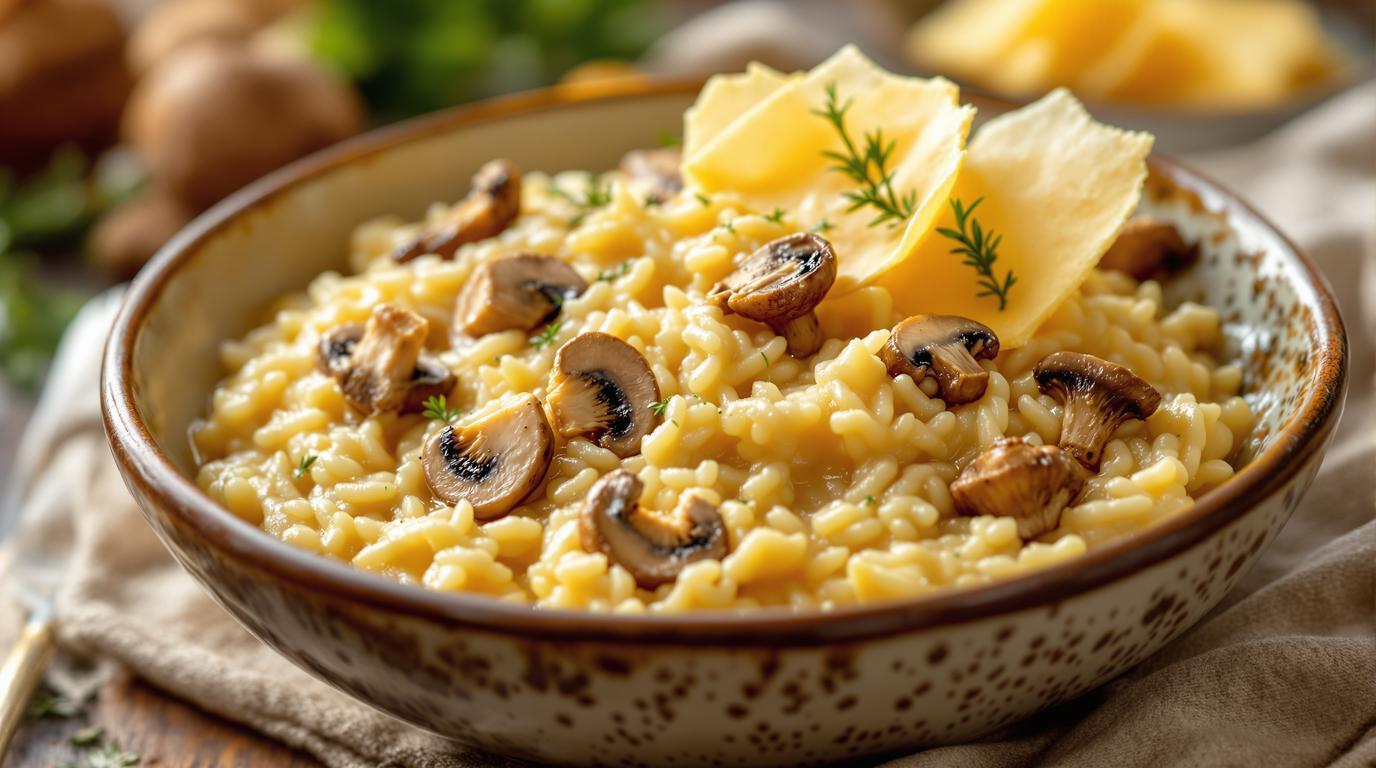There’s something magical about a perfectly executed mushroom risotto that transcends its humble ingredients. During my time in Piemonte, I watched in awe as Maria, an 82-year-old nonna, transformed simple rice and mushrooms into silken gold through nothing but patience and technique. Her secret wasn’t exotic ingredients but the rhythm of her wooden spoon against the pot and her reverence for the process. Today, I’m sharing my version of that transformative dish, elevated with crispy Parmesan chips that shatter gloriously against the creamy canvas below.
The Story
Mushroom risotto finds its roots in Northern Italy’s misty forests and fertile rice fields. What began as peasant cooking—making the most of autumn’s wild porcini bounty—has become a masterclass in technique. The first time I tasted authentic risotto in a small Lombardy trattoria, I realized I’d been making glorified rice pudding my entire career. That revelation changed everything. Unlike many dishes that rely on complex ingredients, risotto’s soul lives in its method—the gentle coaxing of starch from each grain, creating a naturally creamy consistency without a drop of actual cream.
Ingredients Spotlight
The foundation begins with Carnaroli rice (1½ cups/300g)—the “king of risotto rice” with its higher starch content and firmer texture than Arborio. For mushrooms, wild porcini (14oz/400g) deliver the deepest woodland essence, though a mixture of cremini, shiitake and oyster mushrooms works beautifully. The broth (4 cups/1L) should be homemade if possible—chicken for richness, vegetable for clarity. Other essentials include dry white wine (½ cup/120ml), shallot (1 medium, finely diced), unsalted butter (4 tbsp/60g), Parmigiano-Reggiano (1 cup/100g grated, plus 4oz/115g for chips), extra virgin olive oil (3 tbsp), fresh thyme (4 sprigs), and sea salt and freshly cracked black pepper to taste.
Step-by-Step Guide
1. Create Parmesan chips first: Preheat oven to 375°F/190°C. Grate Parmigiano coarsely, then arrange in 2-inch circles on a parchment-lined baking sheet. Bake 5-7 minutes until golden with lacy edges. Let cool completely until crisp.
2. Clean mushrooms with a damp cloth (never submerge—they absorb water like sponges). Slice thickly. Reserve a few slices for garnish.
3. In a heavy-bottomed pot, heat 2 tbsp olive oil over medium heat. Add mushrooms with a pinch of salt and cook undisturbed for 3 minutes before stirring. Continue until golden and their liquid has evaporated, about 8 minutes. Remove two-thirds to a plate.
4. To the same pot, add remaining oil and shallots. Cook until translucent but not browned (3 minutes). Add rice and toast for 2-3 minutes until edges become translucent while centers remain white.
5. Pour in wine, stirring constantly until fully absorbed. Add hot broth one ladleful (about ½ cup) at a time, stirring gently but constantly. Wait until each addition is nearly absorbed before adding more.
6. After 15 minutes, return most mushrooms to the pot, reserving some for garnish. Continue adding broth until rice is al dente—tender but with slight resistance at the center (18-20 minutes total).
7. For the crucial mantecatura: Remove from heat, add butter and grated Parmigiano. Stir vigorously to create a silky emulsion. Cover and rest 2 minutes.
Expert Techniques
The brilliance of risotto lies in its dual textures—each grain remains distinct while swimming in a naturally creamy sauce. This paradox comes from proper toasting (which prevents grains from breaking) followed by the gradual release of starch. Your stirring shouldn’t be aggressive—think gentle waves, not frantic mixing.
Chef’s Note: Temperature control is crucial. Too hot, and the exterior cooks before the interior; too cool, and you’ll end up with porridge. Listen to your risotto—it should maintain a gentle simmer that sounds like quiet whispering.
The mantecatura (butter-cheese emulsion) transforms good risotto into extraordinary risotto. The vigorous stirring creates mechanical heat rather than direct flame, preventing the fats from separating while incorporating air for lightness.
Presentation & Pairing Ideas
Serve immediately on warmed plates—risotto waits for no one. Create a shallow pool rather than a mound, garnishing with reserved mushrooms and strategically placed Parmesan chips standing upright. A light dusting of fresh thyme leaves and black pepper adds aromatic complexity.
For wine, reach for something with bright acidity to cut through the creaminess—a Vermentino or Soave complements without competing. Want something heartier? This risotto pairs beautifully with my Burgundian-style braised short ribs for the ultimate comfort food experience.
For a lighter seasonal variation, substitute asparagus for mushrooms in spring, or add diced roasted butternut squash in autumn. Dietary adaptations? Use olive oil instead of butter and nutritional yeast instead of cheese for a surprisingly successful vegan version.
Remember, risotto isn’t just a recipe—it’s a meditation on patience and attention. Master this technique, and you’ll have unlocked the secret to dozens of variations, from classic slow-cooked comfort foods to sophisticated dinner party centerpieces. Now go stir with purpose, and don’t forget to pour yourself some of that wine! 🍄✨
